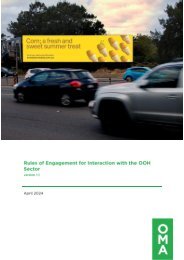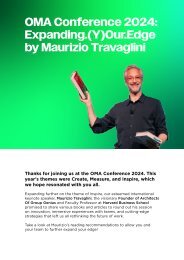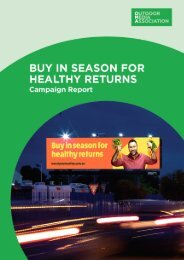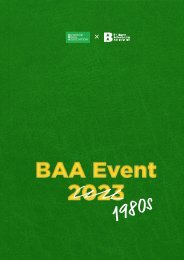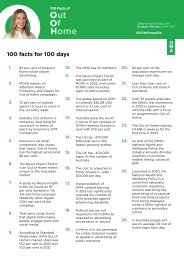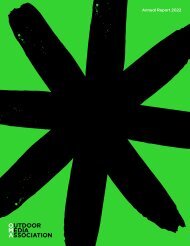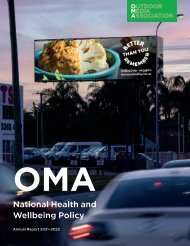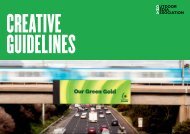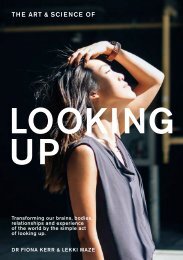OPEN 2
The OPEN series was born from the desire to create a forum for applauding and interrogating strong creative design within the Out of Home (OOH) industry. Illustrating how OOH is part of our cityscape, our commute, our weekend and our shopping and holiday experiences, OOH is ‘the original tweet’ and it cannot be switched off, ignored or fast forwarded. Big, bold, cheeky, simple, clever and controversial, OOH is the ultimate creative stage, allowing brands to be unique, contextually relevant and targeted while reaching mass audiences.
The OPEN series was born from the desire to create a forum for applauding and interrogating strong creative design within the Out of Home (OOH) industry. Illustrating how OOH is part of our cityscape, our commute, our weekend and our shopping and holiday experiences, OOH is ‘the original tweet’ and it cannot be switched off, ignored or fast forwarded. Big, bold, cheeky, simple, clever and controversial, OOH is the ultimate creative stage, allowing brands to be unique, contextually relevant and targeted while reaching mass audiences.
You also want an ePaper? Increase the reach of your titles
YUMPU automatically turns print PDFs into web optimized ePapers that Google loves.
HUMOUR ME<br />
Fiona Jolly, Chief Executive Officer,<br />
Advertising Standards Bureau<br />
...<br />
Wherever we go there are signs of all shapes<br />
and sizes. The question is whether we like<br />
the sign, take any notice of the sign, or even<br />
see the sign. From my years of experience<br />
managing the Advertising Standards Bureau<br />
(ASB) – the complaints arm of Australia’s<br />
advertising self-regulation system – no<br />
advertising is free of its critics, whether<br />
it’s television, radio, internet, print or<br />
Out-of-Home (OOH) advertising.<br />
The fact that OOH by its very nature<br />
is in public places – on billboards, bus shelters,<br />
public transport – and cannot be hidden or<br />
switched off like television, radio or internet<br />
advertisements, means it will consistently<br />
create debate in all sectors – the media,<br />
government, the community, and between<br />
advertisers themselves.<br />
The nature of the ASB’s work has meant<br />
that we have sometimes found ourselves in the<br />
middle of some of these rigorous and, at times,<br />
emotional debates.<br />
In the past five years, the ASB has worked<br />
closely with the Outdoor Media Association<br />
(OMA) in putting forward sensible and factual<br />
submissions to state and federal government<br />
inquiries into OOH, ensuring we covered all<br />
of the issues and criticisms raised.<br />
In working with the OMA, we assured<br />
OOH critics were listened to and we added<br />
their criticisms to our regular research work,<br />
ensuring that we maintain an up-to-date<br />
understanding of community perceptions.<br />
Fielding wide-ranging reactions and<br />
formulating them into what can be termed<br />
‘community standards’ has been part of the<br />
ASB’s work since its inception in 1998. The<br />
ASB has sought constructive feedback through<br />
its various ‘community perceptions’ research<br />
projects and these have provided OOH<br />
advertisers with some evidence and answers<br />
about the reasons for the very different<br />
reactions to outdoor advertising.<br />
To maintain a world-class self-regulatory<br />
system, as well as high standards of advertising,<br />
the continuous work of gauging people’s<br />
reactions and perceptions is essential. This<br />
work has led the charge in ensuring that,<br />
when advertisers create slogans, pictures<br />
and concepts for campaigns, they meet and<br />
do not impinge upon community standards.<br />
Also, importantly, the continual research has<br />
highlighted that people’s reactions, perceptions<br />
and knowledge change over time. Up-to-date<br />
information about issues of community concern<br />
is vital knowledge for advertisers, enabling<br />
them to move in sync with the community.<br />
Although considerable effort goes<br />
into trying to predict where the community<br />
will draw the line, the one subject that can<br />
usually be relied upon to cause complaints<br />
is sex. The list of the most complained-about<br />
advertisements during the past 15 years<br />
makes it clear that people are uncomfortable<br />
with advertisements in the public domain for<br />
certain products and services (eg condoms, sex<br />
assistance) as well as highly sexualised images<br />
(eg nude or topless women, intimacy).<br />
Issues raised by the community were<br />
considered in the research we conducted<br />
into sex, sexuality and nudity in advertising.<br />
Participants were very sensitive to issues<br />
around sex and exposure of children to these<br />
concepts. In particular, they were concerned<br />
about the adoption of sexualised appearance<br />
and behaviours, exacerbated by concerns<br />
about reinforcement of unrealistic body<br />
image expectations and the resultant selfesteem<br />
issues. Explicit or highly sexualised<br />
images were considered most offensive to the<br />
community, which believed they should be<br />
less available to children. The inability to turn<br />
off such OOH was highlighted as a concern.<br />
However, humour, relevance and artistic<br />
23 /



